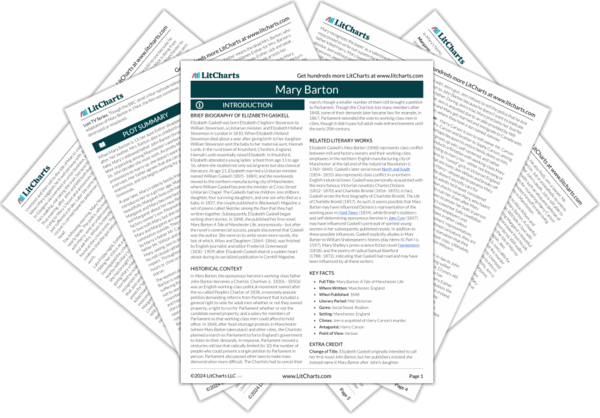Employers vs. Workers
In Mary Barton, class conflict between capitalist employers and the workers they employ does not stem from economic principles or divergent class interests. Rather, the novel argues that employers’ and workers’ interests are intimately bound together—but that employers nevertheless alienate and embitter workers by failing to communicate appropriately with them.
Set in the first half of the 19th century in the English manufacturing town of Manchester, Mary Barton focuses on the conditions and effects…
read analysis of Employers vs. WorkersSexuality and Danger
Mary Barton represents sexuality as fundamentally dangerous—especially to women, but also to working-class men. The novel opens with a discussion of Esther, a young factory worker who has disappeared from her lodging house. Her brother-in-law John Barton immediately assumes that Esther has become embroiled in a premarital romance and will likely end up a sex worker. Subsequent revelations prove him right: Esther has eloped with an army officer who has promised to marry her…
read analysis of Sexuality and DangerChristianity
In Mary Barton, Christian religious virtues such as faith, hope, and love are presented as necessary to a good life and death. Without these virtues, characters go astray, sin, and suffer. For example, Manchester factory worker John Barton loses his religious faith due to the disjunction between the teachings he reads in the Bible and the way the so-called “Christians” around him behave, since these people seem to tolerate glaring forms of inequality. When…
read analysis of Christianity
Poverty and Morality
Mary Barton represents poor people as more likely to act in moral ways than rich people—not because poor people have inherently better moral instincts, but because they are more likely to encounter, recognize, and thus react to others’ needs. Throughout the novel, working-class characters see one another in distress and respond by giving generous aid. For instance, Margaret, a working-class girl with worsening cataracts, sews mourning clothes for an impoverished new widow for free…
read analysis of Poverty and MoralityEmpathy vs. Ignorance
In Mary Barton, empathy springs from knowledge: when people understand the facts of one another’s situations, they empathize with and help one another. By contrast, when people don’t understand one another’s situations, they are more likely to be unsympathetic, callous, cruel, or simply indifferent. Thus, the novel implies that people have a moral duty to be curious about one another’s lives. Frequently in the novel, one character will be hostile or cruel to another…
read analysis of Empathy vs. Ignorance






